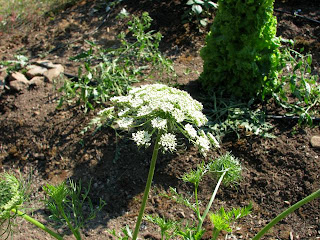

After I did my post on saving spinach and lettuce seed this spring a lot of people have been asking me to tell them more about seed saving. I refer them to the Seed Savers page on saving seed and I am always happy to share what I know, but really what I sense is that they just need reassurance that they can do it too.
This is a carrot going to seed in my garden. I don't save carrot seed because it will cross easily with the wild carrot, Queen Ann's Lace (Daucus carota L.) which is growing everywhere on the homestead. I let it bloom because of the tiny pollinators I always see thronging to it.
There is a little science to it; some squash will cross with each other- but not all, corn is wind pollinated so you need to plant in blocks or shake your corn stalks by hand, tomatoes generally self pollinate and a few little facts like that. I remind beginners that what a blossom crosses with does not show until the next generation, from the seed produced. But it really isn't too hard and what's the worst that will happen? You get a Pumpkinni in your garden next summer. No big deal and fun to boot.

I had an upside down garden at the homestead this year and so I had the odd opportunity to collect seeds from the single miniature fruits of just about everything that I planted that needed heat to produce. A tiny melon the size of a hardball (it didn't taste too bad either), a mini winter squash, the one and only patty pan summer squash and a few tomatoes that performed well in the dreary summer (now those are worth saving).
I put my tomato seed pulp in a jar on the counter for a week or two to let it ferment the gel bags off of the seeds. Even if it molds it is fine. That's how tomatoes reproduce in nature. Be prepared for the smell when you open the jar! Tell everyone in the house what is in the jar or some helpful person may dump them out and wash the jar...
Heirloom plants are the easiest to save seeds from since they are not hybrids and will come true to seed. Choose seeds that are plump and firm. Floppy or thin seeds are not mature.
The most important things to do when saving seeds is to mark them clearly with name and date while drying so they won't get mixed up or tossed out and to make sure they are completely dry before you put them in a bag or jar or they will mold. Keep the seeds out of the bright light and keep them dry and cool. Most seeds will last for at least two or three years. I've planted ten year old tomato seeds and had them do fine.
And remember in the spring that you can plant as many seeds in a hole as you like because you can thin the sprouts (with scissors) when they come up and the seeds were free!
Here's a little slide show of some of my seed saving efforts this fall.






I have yet to really start saving seed. Last year I did save bean seeds but then we were so late getting the garden in this year that I didn't get to plant them.
ReplyDeleteHi Robin, Your bean seeds will be good for next year! Hopefully we'll have a few more days of sun next season. Remember that any produce you have from your garden that is over the hill has seeds in it. If you only planted one kind of summer squash then that old squash on the compost heap is your seed for next year. If you have some plants in your garden that will live through the winter in Oregon- lettuce, cabbage, chard, spinach etc. let them hang out and they will produce seed next spring. You can gather it and dry and plant it within a week or two. Or you can let them self-sow. I have a continuous crop of chard (five color silver beet) because I just let it go and it self seeds. I hoe the ones in the paths and the little birds eat a share of it too.
ReplyDeleteEven on the coldest Oregon winters it hangs in there. In colder climates one can dig the plant up, store it in the root cellar and replant it in the spring and it will produce seed. It's really pretty amazing how generous nature is.
Excellent post on seed saving. I hadn't thought about my carrots crossing with Queen Anne's Lace, but it's true. Not sure what I'll do about that.
ReplyDeleteI do like the self-sowing method of growing garden veggies. Anything that volunteers in my garden, is more than welcome.
I tried to avoid bean and squash crosses by spacing plantings with both time and distance. I'll know next year how well this worked.